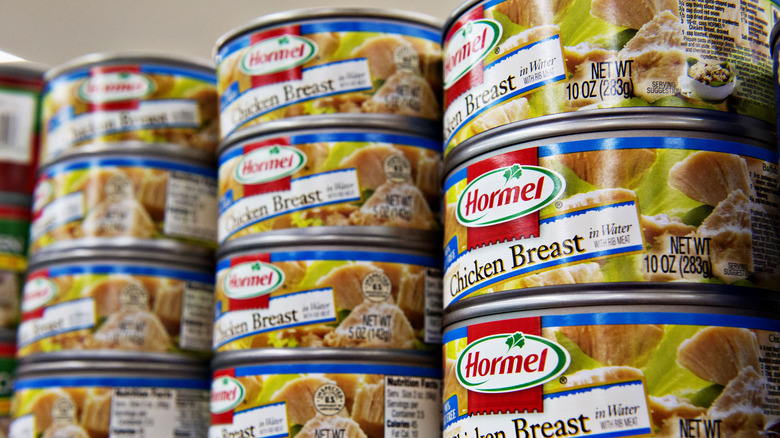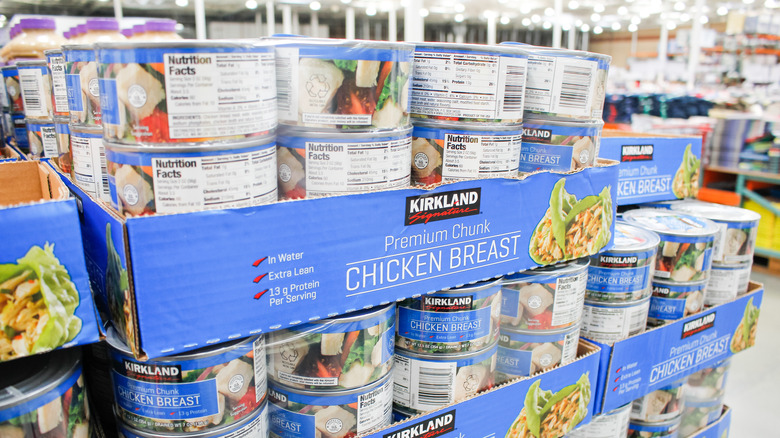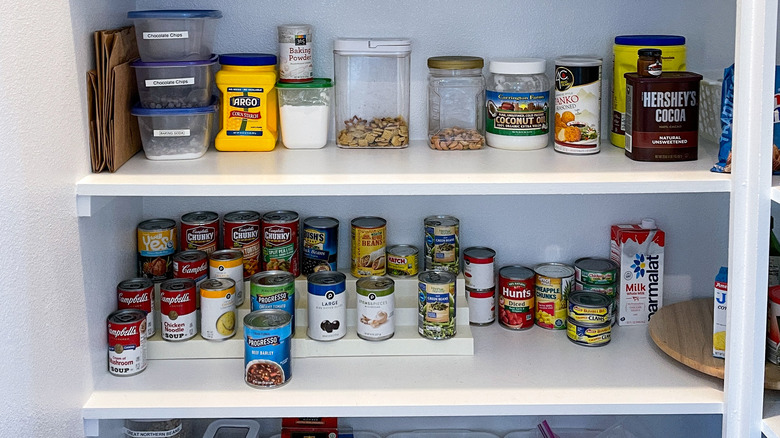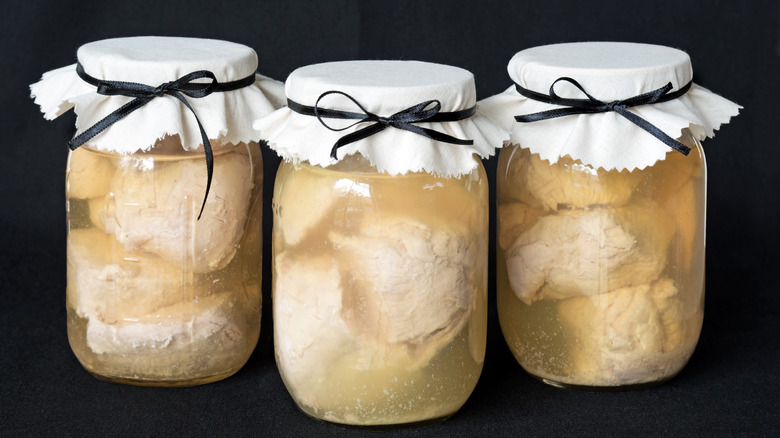The Untold Truth Of Canned Chicken
We may receive a commission on purchases made from links.
Canned meats can be a controversial subject; most people either love it or hate it. It's reasonable to turn your nose up at the idea of canned meat — eating chicken that's been sitting in your pantry for years seems, at best, a little gross. But while it may surprise you, canned chicken is actually perfectly safe to eat. In fact, it's a great option to get many of the health benefits of fresh chicken with none of the required prep time. If you need lean protein that's quick and easy, canned chicken can be a great option.
But of course, it's not all rainbows in the world of canned chicken. Like most canned foods, chicken in a can is highly processed, and it contains large amounts of sodium. And depending on how you use it, sometimes it just doesn't taste very good. But if you arm yourself with knowledge before entering the world of canned meats, you too might become a canned chicken enthusiast.
The chicken usually comes from factory farms
One major downside of eating chicken from a can is that it's likely meat that was raised in inhumane conditions, as Eat This, Not That! explains. Because canned meat requires more processing than fresh meat, the animals are often raised in factories where chickens are crowded and abused. "Much industrial chicken is raised in terrible conditions, and many have infections and are treated with antibiotics," explains Serena Poon, chef and nutritionist, to the publication. This maltreatment isn't just a moral consideration when eating canned meat; it's also a good indication that the meat isn't very good for you: "Antibiotic use in meat production is specifically connected to human health concerns such as antibiotic resistance and child development issues," Poon says.
In addition, industrialized meat lacks some of the nutrition you'll find in fresh chicken. According to Mind Body Green, animals that are fed grains rather than fibrous plants — as most are on factory farms — don't provide you with Vitamin E, beta-carotene, and omega-3 fatty acids as much as fresh chicken does.
Not all cans are created equal
As Mercury News explains, canned chicken isn't known for its flavor. If you're craving chicken, the white, liquid-soaked meat packed into a can in the pantry probably isn't what you have in mind. Without the crispy skin, savory juices, and combination of dark and white meat, chicken dinner just isn't the same. But if you're looking for a nonperishable source of protein or a quick and easy solution to a last-minute meal, you could do worse than a can of chicken — particularly one of these tried-and-true favorites. Mercury News tested several popular canned chicken brands and found that there are a few that take the cake (er, chicken?). Kirkland Signature Premium Chunk Chicken Breast comes out on top with chicken that's tender and moist and, as the publication claims, your best option for a chicken sandwich or salad.
On the other hand, if you come across Hormel Chicken Breast in the canned goods aisle, it's probably best to leave it there. The low amount of sodium in this can was meant to be a selling point, but the flavorless, dry meat tastes more like punishment than piety.
Canned chicken is fully cooked and ready to eat
Before the chicken is canned, it gets fully cooked so it's ready to eat as soon as you open the can. According to Prepared Cooks, all canned chicken is required by the Food and Drug Administration to be cooked to a certain temperature (for chicken, that's usually 165 degrees Fahrenheit) to make sure any harmful pathogens are killed.
When the chicken is canned, it creates a barrier that protects against bacteria and removes the oxygen on which bacteria feeds (via Cook Think). So, canning chicken essentially freezes the meat in time at the perfect point –- just before it's ready to be eaten but before it spoils. The result is chicken that stays fresh and tasty for years (yep, years), just waiting for your next craving. Just make sure you're ready to eat it when you open the can –- the chicken will only stay fresh for a few days once the seal has been broken.
It lasts up to 3-5 years in the pantry
According to Healthline, regular cooked chicken will last in your fridge for about 3-4 days. But if you want to keep chicken on hand for longer, canned chicken is the way to go. As long as it stays sealed, canned chicken will last up to 3-5 years on your shelf. As Still Tasty explains, even though the can might have an expiration date printed on it, that date usually indicates the date at which the chicken surpasses its peak quality. After that date, the chicken is likely still safe to eat, it just might be a little less tasty.
Of course, if you notice a foul smell coming from your chicken when you open the can, you'll want to throw it out regardless of the printed expiration date. Similarly, moldy or discolored chicken should not be eaten. Another good indication that canned food is unsafe is if the can is leaking, rusted, or dented. In these cases, it's best to be on the safe side and buy a new can rather than risk food poisoning.
It's high in sodium
While canned chicken can be both accessible and delicious, it's not something you want to eat every day. That's because excessive amounts of salt are added to most canned foods, including chicken. The Center for Science in the Public Interest website explains that in order to ensure canned foods are bacteria-free, the food is processed in such a way that it is often stripped of its flavor. Salt is a cheap way to make up for that loss.
Unfortunately, though extra sodium may make your food tastier, it doesn't do much for your health. Consuming too much salt can cause high blood pressure and, in more serious cases, heart attack or stroke (via Nutrients).
According to Muscle & Fitness, the amount of sodium in a single can of chicken can range from 500 to 1000 milligrams. For context, the daily recommended sodium intake is less than 2,300 milligrams, and a similar amount of fresh chicken contains fewer than 80 milligrams of sodium (via Verywell Fit).
It's not always a good replacement for fresh chicken
Sometimes canned chicken can be the perfect replacement for the fresh stuff — convenient, non-perishable, and ready as fast as you can open a can, it can save the day in some situations. But be careful — canned chicken isn't always the best alternative to use in all recipes. As Southern Living explains, some of the fresh chicken taste is lost in the canning process, and the result is a salty but otherwise flavorless chicken that can ruin a dish with subtle flavors. Also, when it's incorporated into a recipe that requires additional cooking, canned chicken often leaks out much of the liquid it is soaked in, making for a watery mess.
Southern Living says that cooking a fresh chicken can be simple, and the amplified flavor is worth the extra effort. Plus, as Southern Living recipe tester Paige Grandjean says, "If you take the time to cook your own chicken, you can use the cooking liquid to build your sauce or cook your pasta ... extra flavor!"
You can make your own canned chicken at home
If you want the convenience of canned chicken without the excessive processing of a store-bought can, we have good news for you — with a little effort and, most importantly, a pressure canner, you can preserve your own chicken in the comfort of your own home.
According to Old Fashioned On Purpose, canning chicken at home can be a simple process once you get the hang of it, but it's important to carefully follow canning protocols to ensure your food is safe to eat. But once you've mastered the process, there are significant perks. Canning meat yourself gives you more control over the flavor of the chicken. For example, you can choose to use white meat or dark, keep the bones in or take them out, and even which spices to add. Old Fashioned On Purpose says browning the meat a little before canning makes the finished product extra delicious. Just make sure your equipment is up-to-date and functional, and don't forget to brush up on your food safety knowledge before journeying into the wonderful world of home canning.
For the real canned chicken fans, try a whole chicken in a can!
In a Bon Appetit article, writer Scott Desimon describes finding a Pinafore brand whole chicken in a can in his attic. For Desimon and Bon Appetit, the discovery was magical, something to remember and share with the world, but for canned chicken-heads everywhere, a whole canned chicken is a staple pantry item.
Although Pinafore no longer exists, you can still buy whole canned chicken from a brand called Sweet Sue. And when we say whole chicken, we mean it – Sweet Sue's Whole Canned Chicken includes the whole bird, minus the giblets, plus some extra broth in which to warm up the meat. That's 50 ounces (over 3 pounds) of chicken in a can.
But according to the blog Dave's Cupboard, this product may not be all it's cracked up to be. As you might expect, a whole chicken shoved into a can might not look very appetizing when it slithers out in a mess of broth and salt water. Nonetheless, you simply can't deny the intrigue of an entire chicken ready and available with just the turn of a can opener.








